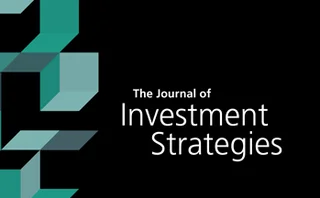Journals
Risk data validation under BCBS 239
Based on a survey of twenty-nine major financial institutions, this paper aims to advise banks and other financial services firms on what is needed to get ready for and become compliant with BCBS 239, especially in the area of risk data validation.
Parameter estimation, bias correction and uncertainty quantification in the Vasicek credit portfolio model
This paper is devoted to the parameterization of correlations in the Vasicek credit portfolio model. First, the authors analytically approximate standard errors for value-at-risk and expected shortfall based on the standard errors of intra-cohort…
Factor investing: get your exposures right!
This paper is devoted to the question of optimal portfolio construction for equity factor investing. The authors discuss the question of multifactor portfolio construction and show that the simplistic approaches often used by practitioners tend to be…
Estimating maturity profiles of nonmaturing deposits
This paper proposes a method to extract deposit lifetime data from individual account transactions.
Funding and credit risk with locally elliptical portfolio processes: an application to central counterparties
In this paper, the authors extend the scaling approach of Andersen et al (2017a) from a model driven by Brownian motion to one driven by an arbitrary isotropic Lévy process.
An efficient portfolio loss model
This paper develops a parsimonious model for evaluating portfolio credit derivatives dependent on aggregate loss.
Recursive estimation of the exponentially weighted moving average model
The aim of this paper is twofold: (i) to introduce two recursive estimation algorithms suitable for the EWMA process that are applicable for routine volatility predictions, and (ii) to investigate their prediction ability by comparing them with other…
Rating migrations of US financial institutions: are different outcomes equivalent?
This study employs a competing risks approach to examine the rating migrations of US financial institutions (FIs) during the period 1984–2006.
Proof-of-work blockchains and settlement finality: a functional interpretation
In this paper, the authors aim to provide an interpretation of the legal issue of settlement finality in the context of proof-of-work distributed ledger technology, such as the Bitcoin network.
Credit rating analysis based on the network of trading information
In this paper, the authors investigate a credit rating problem based on the network of trading information (NoTI).
Central counterparty anti-procyclicality tools: a closer assessment
This paper investigates whether the substantial focus placed on the procyclicality of initial margin reflects both the original concerns at the time of the 2007-8 financial crisis and the intrinsic 'modus operandi' of CCPs.
Default cascades and systemic risk on different interbank network topologies
This paper examines the relationship between the topology of interbank networks and their ability to propagate localized, idiosyncratic shocks across the banking sector via banks’ interbank claims on one another.
Decentralized bottom-up energy trading using Ethereum as a platform
In this paper, the simulated environment of a hierarchical energy trading market using Ethereum’s smartcontract technology is created as a proof-of-concept of using blockchain technology in energy trading.
Path-dependent American options
In this paper, the authors investigate a path-dependent American option problem and provide an efficient and implementable numerical scheme for the solution of its associated path-dependent variational inequality.
Complexity reduction for calibration to American options
In this paper, the authors propose and investigate a new method for the calibration to American option price data.
Quantification of operational risk: statistical insights on coherent risk measures
In this paper, the authors review some of the existing methods used to quantify operational risks in the banking and insurance industries.
The operational risk disclosure practices of banks: evidence from India and Romania
This paper compares the levels of operational risk disclosure in the banking industries of India and Romania.
Community energy retail tariffs in Singapore: opportunities for peer-to-peer and time-of-use versus vertically integrated tariffs
In this paper, an electricity market is simulated using an iterative double-auction algorithm that resolves a social welfare optimization problem based on the Kelly auction mechanism. It is adapted to the case of Singapore.
Making Cornish–Fisher fit for risk measurement
In this paper, the authors develop a computational method to find a unique, corrected Cornish–Fisher distribution efficiently for a wide range of skewnesses and kurtoses.
Counterparty risk: credit valuation adjustment variability and value-at-risk
This paper proposes an efficient method to obtain the distribution of the CVA at a given risk horizon, from which risk measures such as the CVA VaR can be computed.
A statistical technique to enhance application scorecard monitoring
Application scoring plays a critical role in determining the future quality of a lender’s book. It is therefore important to monitor the performance of an application scorecard to ensure it performs as expected.
From log-optimal portfolio theory to risk measures: logarithmic expected shortfall
In this paper, the authors propose a modification of expected shortfall that does not treat all losses equally. We do this in order to represent the worries surrounding big drops that are typical of multiperiod investors.








